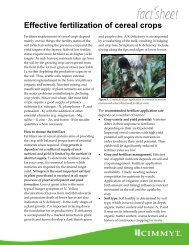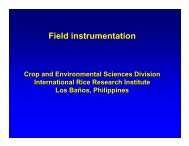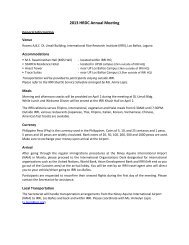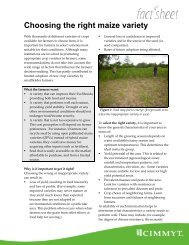Water management in irrigated rice - Rice Knowledge Bank ...
Water management in irrigated rice - Rice Knowledge Bank ...
Water management in irrigated rice - Rice Knowledge Bank ...
- No tags were found...
Create successful ePaper yourself
Turn your PDF publications into a flip-book with our unique Google optimized e-Paper software.
given <strong>in</strong> Table 1.1. <strong>Water</strong> losses by seepage andpercolation account for about 25–50% of all water<strong>in</strong>puts <strong>in</strong> heavy soils with shallow groundwater tablesof 20–50-cm depth (Cabangon et al 2004, Donget al 2004), and 50–85% <strong>in</strong> coarse-textured soilswith deep groundwater tables of 1.5-m depth ormore (Sharma et al 2002, S<strong>in</strong>gh et al 2002). Thoughseepage and percolation are losses at the field level,they are often captured and reused downstream (justlike overbund flow; Chapter 5.1). The actual amountof water reuse <strong>in</strong> <strong>rice</strong>-based irrigation systems isnot known and is expected to vary widely amongirrigation systems.Daily seepage and percolation losses from theponded water do not occur <strong>in</strong> dryland crops suchas wheat and maize. Percolation of water below theroot zone can also occur <strong>in</strong> dryland crops when theamount of water <strong>in</strong>filtrat<strong>in</strong>g <strong>in</strong>to the soil (either afterheavy ra<strong>in</strong>fall or after irrigation) is larger than thestorage capacity of the root zone, but this is not adaily water flow as <strong>in</strong> lowland <strong>rice</strong>. Also, evaporationfrom ponded water surfaces is higher than fromsoil surfaces (as <strong>in</strong> dryland crops). Therefore, it isthe relatively large water flows by seepage, percolation,and evaporation that make lowland <strong>rice</strong>fields heavy “water users.” Total seasonal water<strong>in</strong>put to <strong>rice</strong> fields (ra<strong>in</strong>fall plus irrigation) can beup to 2–3 times more than for other cereals such aswheat or maize (Tuong et al 2005). It varies fromas little as 400 mm <strong>in</strong> heavy clay soils with shallowgroundwater tables (that directly supply waterfor crop transpiration) to more than 2,000 mm <strong>in</strong>coarse-textured (sandy or loamy) soils with deepgroundwater tables (Bouman and Tuong 2001,Cabangon et al 2004). Around 1,300–1,500 mm isa typical value for <strong>irrigated</strong> <strong>rice</strong> <strong>in</strong> Asia. Table 1.1lists some values for water <strong>in</strong>puts and daily seepageand percolation rates for lowland <strong>rice</strong> fields <strong>in</strong>Ch<strong>in</strong>a and the Philipp<strong>in</strong>es.It is useful to dist<strong>in</strong>guish between the wateroutflows from <strong>rice</strong> fields that can, <strong>in</strong> pr<strong>in</strong>ciple, bereused and those that cannot be reused. Nonreusableoutflows are called “depleted water” (Molden1997) and are evaporation and transpiration. Overbundflow, seepage, and percolation are generallyreusable flows. Only when these flows enter verydeep or sal<strong>in</strong>e groundwater (or sal<strong>in</strong>e surface water)from where they cannot be recovered are theynot reusable any more and they become depletionflows as well.1.4 Groundwater under <strong>rice</strong> fieldsThe role of groundwater <strong>in</strong> provid<strong>in</strong>g water to <strong>rice</strong>plants may be large, but it has been neglected <strong>in</strong>most studies of the <strong>rice</strong> water balance. Recent datacollection suggests that through the (decade- toage-old) practice of cont<strong>in</strong>uous flood<strong>in</strong>g, the largeamounts of percolat<strong>in</strong>g water have raised groundwatertables to very close to the surface. This isespecially true <strong>in</strong> soils with a heavy texture that arepoorly dra<strong>in</strong>ed <strong>in</strong> the subsoil, as is the case <strong>in</strong> manytraditional <strong>irrigated</strong> <strong>rice</strong> environments.Figure 1.3 gives the groundwater table measuredunder flooded <strong>rice</strong> fields at some sites <strong>in</strong> Ch<strong>in</strong>aand the Philipp<strong>in</strong>es. When the groundwater is lessthan 20 cm deep, it provides a “hidden” source ofwater to the <strong>rice</strong> crop as the roots of the plants candirectly take up water from the groundwater. Whenfor some reason fields are not flooded (Chapter3), capillary rise may reach <strong>in</strong>to the root zone andaga<strong>in</strong> provide extra water to the crop. In mostwater balance studies, the effect of groundwateron water supply is not taken <strong>in</strong>to account, and thebeneficial effect of water-sav<strong>in</strong>g technologies canbe overestimated. With shallow groundwater, cropgrowth with a small irrigation water supply can stillbe good because of the “hidden” water supply ofgroundwater.1.5 <strong>Rice</strong> water productivity<strong>Water</strong> productivity (WP) is a concept of partialproductivity and denotes the amount or value ofproduct (<strong>in</strong> our case, <strong>rice</strong> gra<strong>in</strong>s) over volume orvalue of water used. Discrepancies are large <strong>in</strong> reportedvalues of WP of <strong>rice</strong> (Tuong 1999). These arepartially caused by large variations <strong>in</strong> <strong>rice</strong> yields,with commonly reported values rang<strong>in</strong>g from 3 to8 tons per hectare. But the discrepancies are alsocaused by different understand<strong>in</strong>gs of the denom<strong>in</strong>ator(water used) <strong>in</strong> the computation of WP. Toavoid confusion created by different <strong>in</strong>terpretationsand computations of WP, it is important to clearlyspecify what k<strong>in</strong>d of WP we are referr<strong>in</strong>g to andhow it is derived. Common def<strong>in</strong>itions of WP areWP T: weight of gra<strong>in</strong>s over cumulative weightof water transpired.WP ET: weight of gra<strong>in</strong>s over cumulative weightof water evapotranspired.WP I: weight of gra<strong>in</strong>s over cumulative weightof water <strong>in</strong>puts by irrigation.


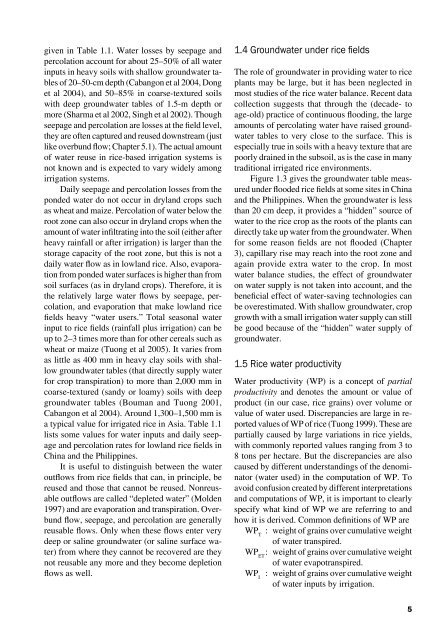


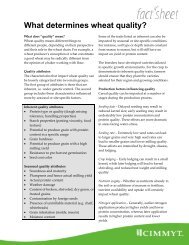

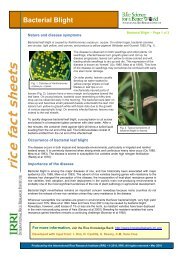

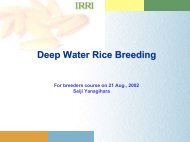
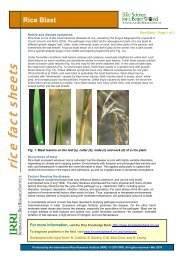
![International Standards' Organization â Rice Specification [ISO 7301]](https://img.yumpu.com/36696862/1/190x245/international-standards-organization-a-rice-specification-iso-7301.jpg?quality=85)

